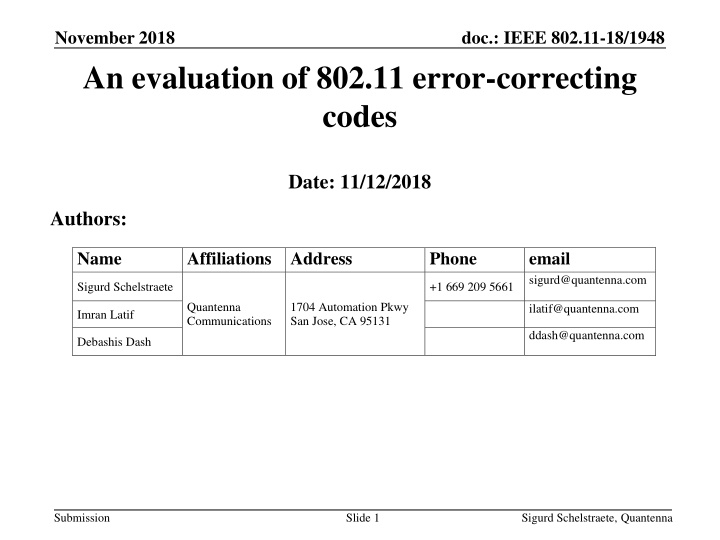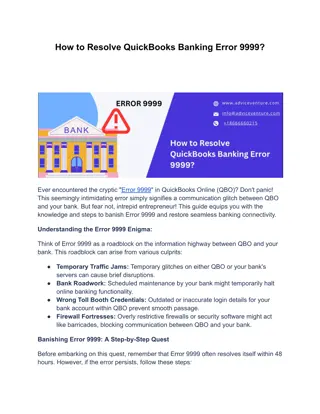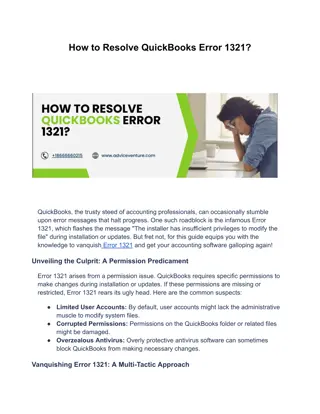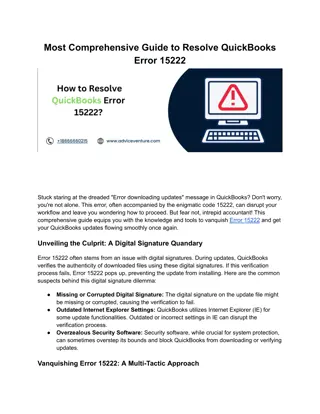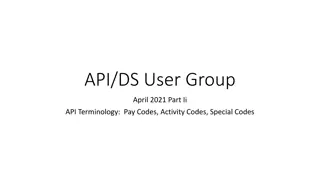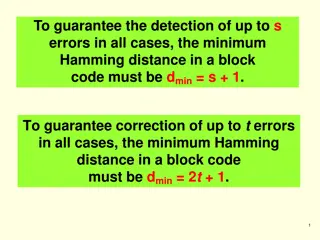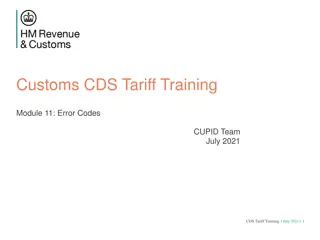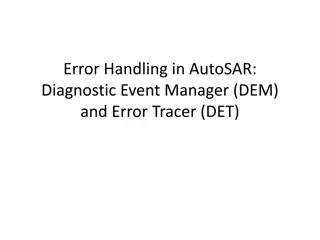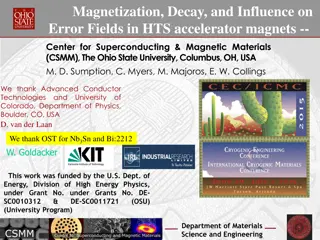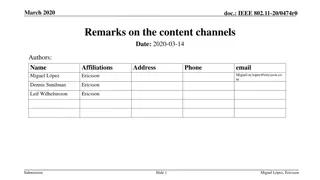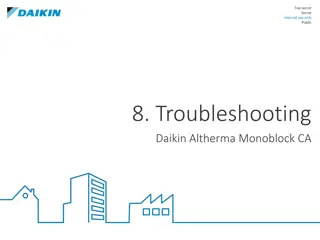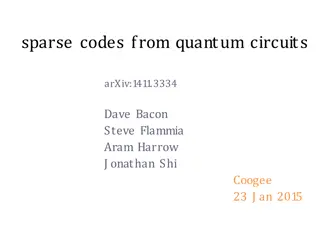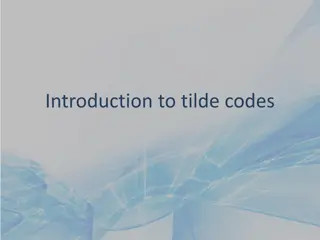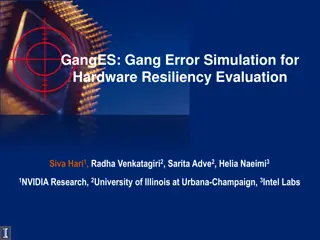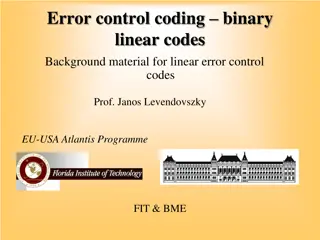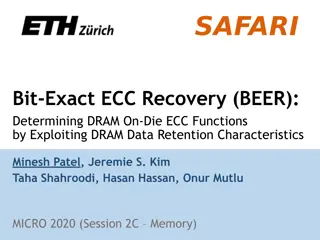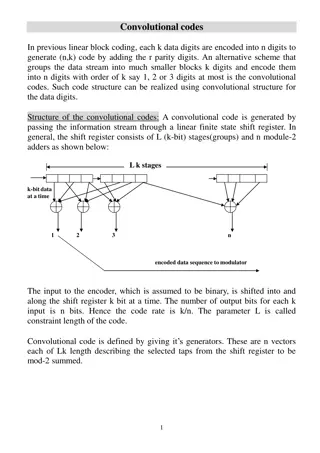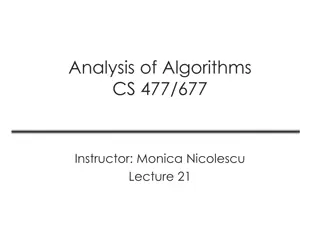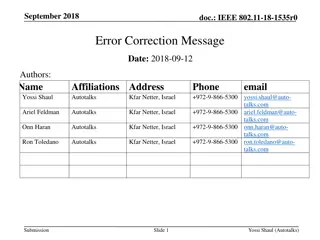Evaluation of 802.11 Error-Correcting Codes in IEEE 802.11-18/1948
This evaluation delves into the performance of error-correcting codes in the context of IEEE 802.11 standards, focusing on improvements made over generations, such as the transition to LDPC coding schemes. It discusses how well the current Forward Error Correction (FEC) techniques align with the Shannon limit and highlights potential areas for further enhancements.
Download Presentation

Please find below an Image/Link to download the presentation.
The content on the website is provided AS IS for your information and personal use only. It may not be sold, licensed, or shared on other websites without obtaining consent from the author.If you encounter any issues during the download, it is possible that the publisher has removed the file from their server.
You are allowed to download the files provided on this website for personal or commercial use, subject to the condition that they are used lawfully. All files are the property of their respective owners.
The content on the website is provided AS IS for your information and personal use only. It may not be sold, licensed, or shared on other websites without obtaining consent from the author.
E N D
Presentation Transcript
November 2018 An evaluation of 802.11 error-correcting codes doc.: IEEE 802.11-18/1948 Date: 11/12/2018 Authors: Name Affiliations Address Phone email sigurd@quantenna.com ilatif@quantenna.com Sigurd Schelstraete +1 669 209 5661 Quantenna Communications 1704 Automation Pkwy San Jose, CA 95131 Imran Latif ddash@quantenna.com Debashis Dash Submission Slide 1 Sigurd Schelstraete, Quantenna
November 2018 doc.: IEEE 802.11-18/1948 Introduction: 802.11 FEC generations 802.11a defines BCC codes with coding rates 1/2, 2/3 and BCC is the only FEC scheme 802.11n added BCC with rate 5/6 and introduced LPDC codes as an optional FEC scheme Block sizes 648, 1296 and 1944 bits 802.11ac maintained the 802.11n FEC schemes 802.11ax makes LPDC mandatory for a majority of cases Submission Slide 2 Sigurd Schelstraete, Quantenna
November 2018 doc.: IEEE 802.11-18/1948 How well does the current FEC perform? Typically, coding performance is measured against the Shannon limit Theoretical SNR limit at which error-free transmission can be achieved Any gap between the performance of the code at a given BER (e.g. 10-6) and the Shannon limit can be seen as a measure of quality for the code Some caveats: Comparing error-free performance vs. performance at chosen BER is not unambiguous The Shannon limit does not assume any specific modulation Submission Slide 3 Sigurd Schelstraete, Quantenna
November 2018 doc.: IEEE 802.11-18/1948 The Shannon limit The Shannon limit defines the capacity of the channel at a given SNR as: ? = ??? 1 +? ? There is also a discrete-constellation version of the Shannon limit that applies when the modulation is fixed (e.g. QAM, PAM, ) Needs to be derived numerically For K equiprobable signal points: + ?? 2?2 2 ?2 1 ? ? ?? ? = ??? ? ??? ??? ? ?? ?? Submission Slide 4 Sigurd Schelstraete, Quantenna
November 2018 doc.: IEEE 802.11-18/1948 The Shannon limit(s) Uncoded performance at 10-6 is about 8-10 dB away for the Shannon limit Submission Slide 5 Sigurd Schelstraete, Quantenna
November 2018 doc.: IEEE 802.11-18/1948 Performance of current coding schemes LDPC improves about 2 dB over BCC About 1.5 to 2 dB gap with the discrete constellation limit About 3.5 dB gap to unconstrained Shannon limit Submission Slide 6 Sigurd Schelstraete, Quantenna
November 2018 doc.: IEEE 802.11-18/1948 Conclusions Current 802.11 FEC compare relatively well to Shannon limit LDPC has narrowed the gap Some gap to full capacity remains Anecdotical evidence that further coding gain is possible The complexity needed to narrow this gap is unknown Possible considerations: Typically, longer LDPC codes improve performance Note that 802.3ca has already adopted a 18K LDPC block code [1] 3GPP has defined LDPC with block size 8448 [2] Would TCM in combination with LDPC result in further improvement? Submission Slide 7 Sigurd Schelstraete, Quantenna
November 2018 doc.: IEEE 802.11-18/1948 Recommendation Incremental improvement in coding gain may be possible over the currently defined codes for 802.11 Given that: Current FEC schemes haven t been updated in 10 years Other projects have adopted newer codes Further improvements appear possible We recommend that EHT considers review of FEC within scope of the project Submission Slide 8 Sigurd Schelstraete, Quantenna
November 2018 doc.: IEEE 802.11-18/1948 References [1] FEC Proposal for NGEPON, laubach_3ca_1a_1117, http://www.ieee802.org/3/ca/public/meeting_archive/2017/11/laubach_3 ca_1a_1117.pdf [2] 3GPP TS 38.212, NR; Multiplexing and channel coding Submission Slide 9 Sigurd Schelstraete, Quantenna
